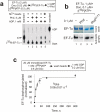The Fic protein Doc uses an inverted substrate to phosphorylate and inactivate EF-Tu
- PMID: 24141193
- PMCID: PMC3836179
- DOI: 10.1038/nchembio.1364
The Fic protein Doc uses an inverted substrate to phosphorylate and inactivate EF-Tu
Abstract
Fic proteins are ubiquitous in all of the domains of life and have critical roles in multiple cellular processes through AMPylation of (transfer of AMP to) target proteins. Doc from the doc-phd toxin-antitoxin module is a member of the Fic family and inhibits bacterial translation by an unknown mechanism. Here we show that, in contrast to having AMPylating activity, Doc is a new type of kinase that inhibits bacterial translation by phosphorylating the conserved threonine (Thr382) of the translation elongation factor EF-Tu, rendering EF-Tu unable to bind aminoacylated tRNAs. We provide evidence that EF-Tu phosphorylation diverged from AMPylation by antiparallel binding of the NTP relative to the catalytic residues of the conserved Fic catalytic core of Doc. The results bring insights into the mechanism and role of phosphorylation of EF-Tu in bacterial physiology as well as represent an example of the catalytic plasticity of enzymes and a mechanism for the evolution of new enzymatic activities.
Figures






Comment in
-
Enzyme mechanisms: What's up 'Doc'?Nat Chem Biol. 2013 Dec;9(12):756-7. doi: 10.1038/nchembio.1379. Epub 2013 Oct 20. Nat Chem Biol. 2013. PMID: 24141194 No abstract available.
References
Publication types
MeSH terms
Substances
Grants and funding
LinkOut - more resources
Full Text Sources
Other Literature Sources
Molecular Biology Databases

